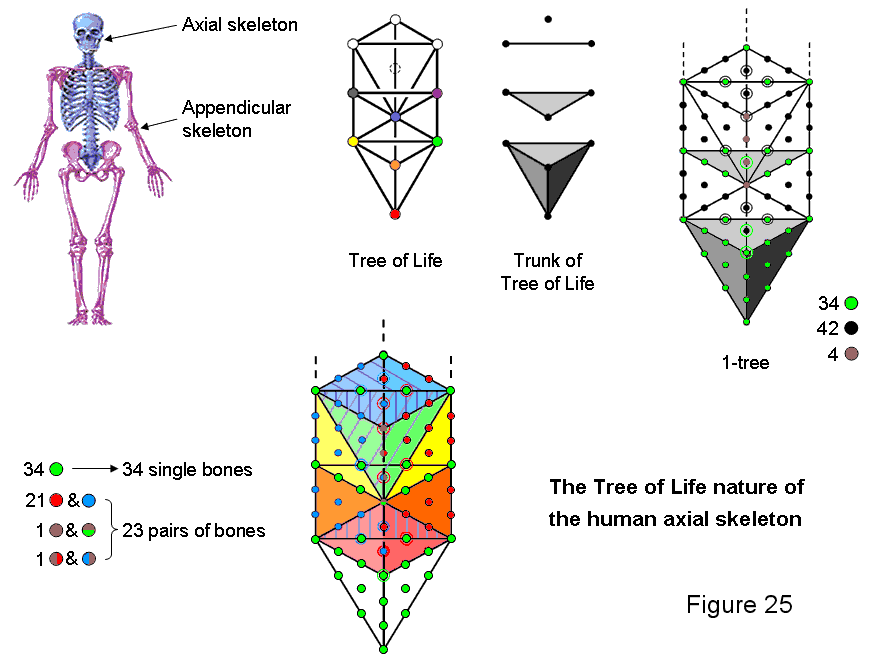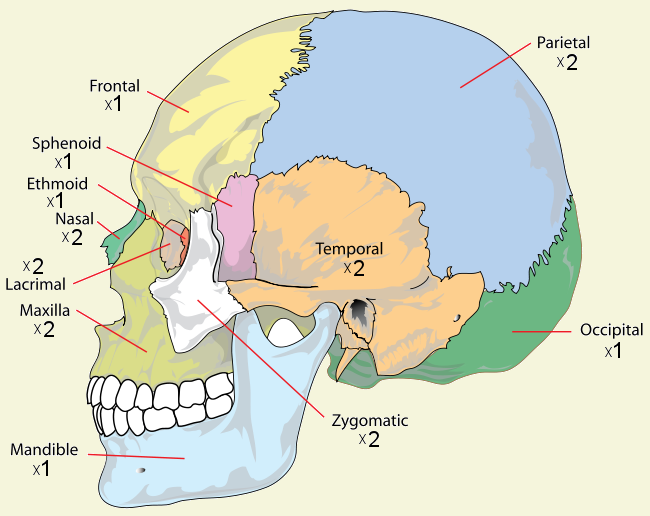
| << Previous 1... 11 12 13 [14] 15 Next >> |
#14 The Tree of Life basis of the human axial skeleton

As the inner and outer Trees of Life possess corresponding properties (e.g., the former's (7+7) enfolded polygons have 70 corners and the latter has 70 yods when its triangles are tetractyses), the human skeleton is encoded not only in the inner form of the Tree of Life but also in the traditional, Kabbalistic representation of Adam Kadmon, the divine prototype, as now proved.
The trunk of the Tree of Life (Fig. 25) consists of the mathematical sequence:
When the 19 triangles of the 1-tree are turned into tetractyses, they contain 80 yods, where 80 is the number value of Yesod (meaning "Foundation"):
Geometrical composition of the 1-tree.
|
Number of corners |
Number of hexagonal yods |
Total |
|
| Trunk Point Line Triangle Tetrahedron |
|
|
|
| Subtotal |
10 |
25 |
35 |
| Branches |
1 |
44 |
45 |
| Total |
11 |
69 |
80 |
Its trunk (the geometrical representation of the integers 1, 2, 3 & 4) contains 10 points that are corners of tetractyses and 25 hexagonal yods, totalling 35 green yods. The remainder of the 1-tree with 45 yods is its branches. Or not quite. The vertical Path joining Daath and Tiphareth will be called the 'root' of the 1-tree. The 1-tree is the Tree of Life that has taken root and grown into more than just its rudimentary, generic form. The term 'root' is appropriate because the root edge shared by the two sets of seven enfolded polygons of the inner Tree of Life is the projection of this Path onto the plane containing them. Lying on the root of the 1-tree are two brown hexagonal yods. Its brown upper endpoint is Daath (Yesod of the next higher Tree), which is not part of the trunk. Its brown lower endpoint is Tiphareth, which is part of the trunk, being one of the Sephiroth of the Tree of Life. Hence, the root comprises one yod that belongs also to the trunk and three yods that do not. Because of this sharing, the trunk has 34 green yods, the root has four brown yods and the branches have 42 black yods. However, we may regard Tiphareth as the part of the Tree that is simultaneously part of the root and part of the trunk, i.e., the junction between the two. For this reason, in the final diagram the three yods that belong to the root per se are coloured brown and the yod shared with the trunk is coloured half brown and half green. The 19 tetractyses in the 1-tree comprise the five tetractyses in the trunk and the14 tetractyses in its branches. The axial mirror symmetry of the 1-tree means that five tetractyses on the right-hand side of the central Pillar of Equilibrium as axis (coloured red, orange, yellow, green & blue) have their reflected counterparts on its left-hand side (coloured lighter shades of these colours). Yods not belonging to the trunk are coloured red in those on the right and blue in those on the left (sides shared by two mirror-image tetractyses have one red and one blue). Four tetractyses (two with indigo stripes, two with violet stripes) straddle the axis. Can we group them into two pairs even though they are not chiral — unlike the five other pairs of tetractyses, whose yods can be groups into pairs of yods and its mirror reflection? Intuitively, the two endpoints of the root are the mirror images of each other, as are its two hexagonal yods, because they denote the beginning of the expansive phase and the completion of the contractive phase of the generation of the 14 polygons of the inner Tree of Life. They are the Yang and the Yin qualities embodied in, respectively, the Pillars of Mercy and Judgement. Therefore, the four brown yods can be grouped into one pair of polar opposites consisting of a brown yod (Daath) and a half-brown/half-green yod (Tiphareth) and one pair consisting of a half-brown/half-red yod and a half-brown/half-blue yod. The triangle with vertical indigo stripes with Chokmah, Binah & Daath at its corners is the polar opposite of the indigo-striped triangle with Tiphareth, Netzach & Hod at its corners because Tiphareth is the "opposite" of Daath in the sense indicated above. The violet-striped triangle with Kether, Chokmah & Binah at its corners can be paired with the violet-striped triangle with Chokmah, Binah & Tiphareth at its corners. This generates (7+7) triangles that make up the branches with 23 pairs of yods. They are shown in the last diagram coloured the seven colours of the rainbow and seven lighter shades.
The 34 yods exclusive to the five tetractyses in the trunk of the outer Tree of Life correspond to the 34 single bones in the axial skeleton. The 23 pairs of yods in the root and branches correspond to the 23 pairs of bones in the axial skeleton, one located on the left-hand side of the body and one sited on the right-hand side as its mirror image. The 80 yods in the 1-tree symbolize the 80 bones making up the axial skeleton.
The 126 bones in the appendicular skeleton are explained in Article 32 to correspond to the 126 yods that are added to the branches of the 1-tree when its 19 triangles are regarded as Type A triangles. In this more complete description of the human skeleton, the 80 bones of the axial skeleton are symbolized by the 80 yods that make up the root and trunk of the 1-tree.
 Let us now see whether the anatomy of the human axial skeleton provides evidence for its 23 pairs
of bones consisting of two pairs of bones that correspond to the four yods of the Daath-Tiphareth Path (the
root of the 1-tree) and 21 pairs of bones that correspond to the
21 pairs of yods in the 14 tetractyses in the branches of the 1-tree. A group of N bones
made up of n single bones and m pairs of bones (one on each side of the body) can be written as:
Let us now see whether the anatomy of the human axial skeleton provides evidence for its 23 pairs
of bones consisting of two pairs of bones that correspond to the four yods of the Daath-Tiphareth Path (the
root of the 1-tree) and 21 pairs of bones that correspond to the
21 pairs of yods in the 14 tetractyses in the branches of the 1-tree. A group of N bones
made up of n single bones and m pairs of bones (one on each side of the body) can be written as:
N = n×1 + m×2.
("×1" denotes a single bone and "×2" denotes a bone paired with its counterpart on the other side of the body). Here is the bone composition of the axial skeleton:
Skull (28)
cranium: 8 = 4×1 + 2×2;
face: 14 = 2×1 + 6×2;
ossicles: 6 = 3×2;
Total = 28 = 8 + 14 + 6 = 6×1 + 11×2.
Hyoid (1)
1 = 1×1;
Vertebrae (26)
cervical: 7 = 7×1;
thoracic vertebrae: 12 = 12×1;
lumbar vertebrae: 5 = 5×1;
sacrum: 1 = 1×1;
coccyx: 1′ = 1×1;
Total = 26 = 7 + 12 + 5 + 1 + 1′ = 26×1.
Thoracic cage (25)
sternum: 1″ = 1×1;
ribs: 24 = 12×2;
Total = 25 = 1″ + 24 = 1×1 + 12×2.
Adding together the single bones and the pairs of bones in the axial skeleton,
80 = 28 + 1 + 26 + 25
= 34×1 + 23×2.
The most appropriate candidates for the 'root' of the axial skeleton whose Tree of Life counterpart is two pairs of yods are the pair of parietal bones and the pair of temporal bones (the two pairs of bones in the cranium, the top of the skull, i.e., an extremity of the skeleton). The six pairs of bones in the face, the three pairs of ossicles and the 12 pairs of ribs cannot be regarded as extremities. So we see that four bones as two pairs are, indeed, anatomically differentiated from the other pairs of bones in the axial skeleton, just as our analysis predicts.
| << Previous 1... 11 12 13 [14] 15 Next >> |